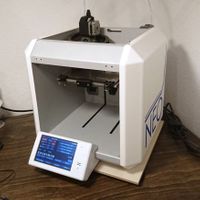Using a rotary position sensor as filament sensor
-
I am currently trying to figure out the details on how to setup a Duet to work with a Snapmaker J1. Apart from having pre-amplifiers for the hotend temperatures sensors (these might work in a similar fashion as mentioned here in the forum), it uses a copy of a Murata SV01 as filament sensor which produces a 0...3.3V sawtooth voltage as output.
Two questions about this one:
- While I guess I might configure this sensor as a pulse-generating sensor, I wonder if there might be a way to use the analogue signal to increase sensitivity?
- Murata states that they suggest an input with high impedance of 1M or more. Do the io*_in pins of the 6HC qualify for this with the internal pullup resistor being disabled or do I need to physically remove the 27K resistors shown in the schematic?
(edit removed typo)
-
 undefined NeoDue marked this topic as a question
undefined NeoDue marked this topic as a question
-
@NeoDue Okay, I can partially answer the first question myself - I can define the sensor as an analog input sensor with M308. What I do not know however is how to tell the Duet that this input qualifies as a filament sensor.
The Duet filament sensor however converts its analogue values in its own processor and sends them to the Duet, so I guess that the Duet is not capable to do that (i.e. using the analogue value for filament sensing) by herself. Is that assumption correct?
-
@NeoDue that's correct, RRF does not have any facility for using an analog filament sensor. You could perhaps use an Arduino Nano or similar to convert that analog output to the digital format sent by the Duet3D filament monitors.
-
@dc42 thanks a lot! Then it seems I have two options: either replacing the servo potentiometer with e.g. a hall sensor that fits into the original housing (the brass wheel in there is definitely big enough to work with a whole bunch of 1mm magnets being added) or going the way you suggested with the Arduino... the former might be beneficial when I look at the data sheet lifetime of an SV01 though.
-
 undefined NeoDue has marked this topic as solved
undefined NeoDue has marked this topic as solved